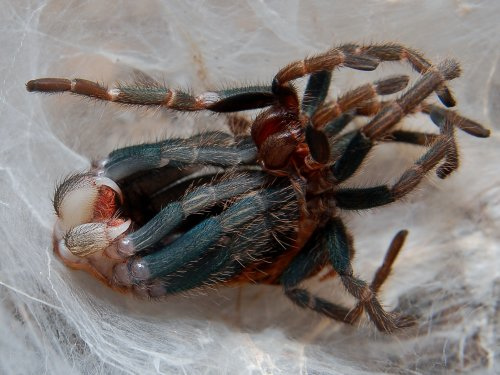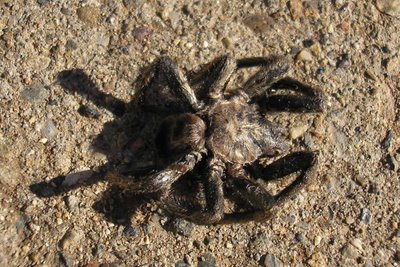GENERAL INFORMATION
Rose Hair Tarantulas are the most popular pet tarantulas, due to it's attractive color, calm temperament and inexpensive price compared to other tarantulas. Do not house more than one Rose Hair Tarantula in the same enclosure, they are extremely aggressive towards each other. You will end up with one or no tarantulas if you mix them! Tarantulas carry their skeletons on the outside. Do not let tarantulas fall for more than a couple of inches since this can split the exoskeleton open if dropped. If your tarantula loses a leg, it will eventually grow a new one in it's place with successive molts.
MOLTING
Molting is a stressful time for your tarantula, give them some alone time and darkness and do not disturb them. Some signs of premolt are when there abdomens darken and they act more sluggish then usual and do not accept food. When they molt they may web all over the place making it secure for them, then they flip on their back and start there process witch may take up a full day or just a couple of hours. When they on their back they are not dead!!! Example below

ADULT SIZE
4-6 inches
ENCLOSURE
Tarantulas for the most part are inactive. Therefore small enclosures are ideal. 5-10 gallon tanks work well with a secure lid.
SUBSTRATE
Use 3 to 4 inches of slightly damp peat moss, vermiculite, coco fiber, or sphagnum moss are all fine choices. Each will hold moisture well. Keep only slightly damp.
TEMPERATURE & HUMIDITY
Rose Hairs will live comfortably with the temperature set around 70-80ºf. Rose hairs are desert species so they like it dry. Keeping a water dish will give all the humidity a rose hair will need. From keeping your substrate to dry lightly mist the enclosure once or twice a week.
FOOD/WATER
Tarantulas will eat crickets, roaches and other insects and small vertebrates.
Do not over feed your tarantula it's very unhealthy, they only require 1-3 crickets a week. They generally wont eat when there in premolt, and after they molt give them about a week so that there exoskeleton can harden up. Never leave live food in the enclosure unattended. Provide a shallow water dish and clean it regularly and do not use sponges they are breeding grounds for harmful bacteria.
HEATING
Use a heat mat and place it on the side of the enclosure. You should have a temp gauge to monitor the temp inside the enclosure.
LIGHTING
No lighting, lighting is harmful to tarantulas
Death Curl
Result of a dead tarantula. Example below

Rose Hair Tarantulas are the most popular pet tarantulas, due to it's attractive color, calm temperament and inexpensive price compared to other tarantulas. Do not house more than one Rose Hair Tarantula in the same enclosure, they are extremely aggressive towards each other. You will end up with one or no tarantulas if you mix them! Tarantulas carry their skeletons on the outside. Do not let tarantulas fall for more than a couple of inches since this can split the exoskeleton open if dropped. If your tarantula loses a leg, it will eventually grow a new one in it's place with successive molts.
MOLTING
Molting is a stressful time for your tarantula, give them some alone time and darkness and do not disturb them. Some signs of premolt are when there abdomens darken and they act more sluggish then usual and do not accept food. When they molt they may web all over the place making it secure for them, then they flip on their back and start there process witch may take up a full day or just a couple of hours. When they on their back they are not dead!!! Example below

ADULT SIZE
4-6 inches
ENCLOSURE
Tarantulas for the most part are inactive. Therefore small enclosures are ideal. 5-10 gallon tanks work well with a secure lid.
SUBSTRATE
Use 3 to 4 inches of slightly damp peat moss, vermiculite, coco fiber, or sphagnum moss are all fine choices. Each will hold moisture well. Keep only slightly damp.
TEMPERATURE & HUMIDITY
Rose Hairs will live comfortably with the temperature set around 70-80ºf. Rose hairs are desert species so they like it dry. Keeping a water dish will give all the humidity a rose hair will need. From keeping your substrate to dry lightly mist the enclosure once or twice a week.
FOOD/WATER
Tarantulas will eat crickets, roaches and other insects and small vertebrates.
Do not over feed your tarantula it's very unhealthy, they only require 1-3 crickets a week. They generally wont eat when there in premolt, and after they molt give them about a week so that there exoskeleton can harden up. Never leave live food in the enclosure unattended. Provide a shallow water dish and clean it regularly and do not use sponges they are breeding grounds for harmful bacteria.
HEATING
Use a heat mat and place it on the side of the enclosure. You should have a temp gauge to monitor the temp inside the enclosure.
LIGHTING
No lighting, lighting is harmful to tarantulas
Death Curl
Result of a dead tarantula. Example below